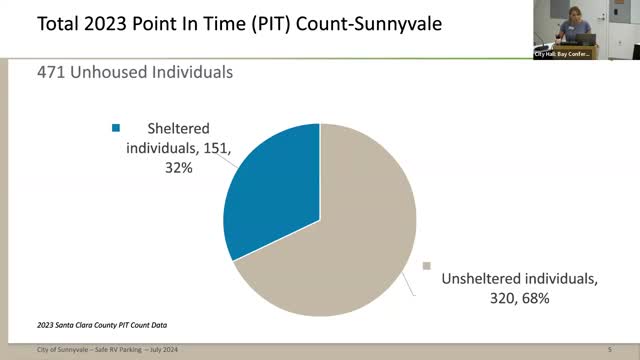Sunnyvale faces rising crisis of vehicular homelessness
August 03, 2024 | Sunnyvale , Santa Clara County, California

This article was created by AI summarizing key points discussed. AI makes mistakes, so for full details and context, please refer to the video of the full meeting. Please report any errors so we can fix them. Report an error »

The latest data from a government meeting reveals a pressing homelessness crisis in Sunnyvale, with 151 individuals currently sheltered and 320 unsheltered as of 2023. The unsheltered population includes those living on the streets, in cars, and in other unsuitable locations.
A recent assessment conducted by the Santa Clara County Office of Supportive Housing highlighted that 452 households in Sunnyvale experienced homelessness between July 2023 and May 2024. This data underscores the urgent need for safe parking solutions, as many individuals are opting to shelter in their vehicles rather than traditional accommodations.
The city’s environmental services department conducted a windshield tour to gather data on vehicular homelessness, although it noted that not all RVs counted may contain individuals experiencing homelessness. The transient nature of those living in vehicles complicates accurate counts, as many prefer to remain unnoticed.
Key factors contributing to vehicular homelessness include the inability to afford rent, displacement due to natural disasters, and pandemic-related social distancing measures that reduced shelter capacity. Vehicles often provide a sense of safety and security for personal belongings, making them a preferred option for some over shelters, which may have restrictions on pets or family members.
However, living in vehicles poses significant health and safety risks. Vehicle dwellers often lack access to basic sanitation facilities, which can lead to health issues. The confined space of a vehicle can exacerbate chronic illnesses and contribute to mental health challenges, including anxiety and depression. Additionally, the visibility of personal belongings can increase the risk of theft, affecting both the individuals living in vehicles and the surrounding community.
The meeting highlighted the urgent need for comprehensive strategies to address homelessness in Sunnyvale, particularly for those living in vehicles, to ensure their safety and well-being.
A recent assessment conducted by the Santa Clara County Office of Supportive Housing highlighted that 452 households in Sunnyvale experienced homelessness between July 2023 and May 2024. This data underscores the urgent need for safe parking solutions, as many individuals are opting to shelter in their vehicles rather than traditional accommodations.
The city’s environmental services department conducted a windshield tour to gather data on vehicular homelessness, although it noted that not all RVs counted may contain individuals experiencing homelessness. The transient nature of those living in vehicles complicates accurate counts, as many prefer to remain unnoticed.
Key factors contributing to vehicular homelessness include the inability to afford rent, displacement due to natural disasters, and pandemic-related social distancing measures that reduced shelter capacity. Vehicles often provide a sense of safety and security for personal belongings, making them a preferred option for some over shelters, which may have restrictions on pets or family members.
However, living in vehicles poses significant health and safety risks. Vehicle dwellers often lack access to basic sanitation facilities, which can lead to health issues. The confined space of a vehicle can exacerbate chronic illnesses and contribute to mental health challenges, including anxiety and depression. Additionally, the visibility of personal belongings can increase the risk of theft, affecting both the individuals living in vehicles and the surrounding community.
The meeting highlighted the urgent need for comprehensive strategies to address homelessness in Sunnyvale, particularly for those living in vehicles, to ensure their safety and well-being.
View full meeting
This article is based on a recent meeting—watch the full video and explore the complete transcript for deeper insights into the discussion.
View full meeting
